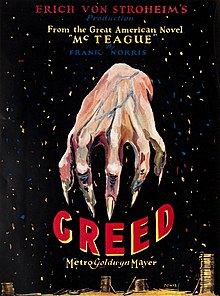| Greed | |
|---|---|
 Theatrical release poster | |
| Directed by | Erich von Stroheim |
| Screenplay by |
|
| Based on | McTeague 1899 novel by Frank Norris |
| Produced by |
|
| Starring | |
| Cinematography |
|
| Edited by |
|
| Music by | William Axt |
Production company | The Goldwyn Company–Metro-Goldwyn |
| Distributed by | Metro-Goldwyn-Mayer |
Release date |
|
Running time | |
| Country | United States |
| Languages |
|
| Budget | $665,603 |
| Box office | $274,827 |
Greed is a 1924 American silent psychological drama film written and directed by Erich von Stroheim and based on the 1899 Frank Norris novel McTeague. It stars Gibson Gowland as Dr. John McTeague; ZaSu Pitts as Trina Sieppe, his wife; and Jean Hersholt as McTeague's friend and eventual enemy Marcus Schouler. The film tells the story of McTeague, a San Francisco dentist, who marries his best friend Schouler's girlfriend Trina.
Greed was one of the few films of its time to be shot entirely on location, with von Stroheim shooting approximately 85 hours of footage before editing. Two months alone were spent shooting in Death Valley for the film's final sequence, and many of the cast and crew became ill. Von Stroheim used sophisticated filming techniques such as deep focus cinematography and montage editing. He considered Greed to be a Greek tragedy, in which environment and heredity controlled the characters' fates and reduced them to primitive bêtes humaines (human beasts), a naturalistic concept in the vein of Zola.
During editing, the production company merged into Metro-Goldwyn-Mayer (MGM), putting Irving Thalberg in charge of post-production. Thalberg had fired von Stroheim a few years earlier at Universal Pictures. Originally almost eight hours long, Greed was edited against von Stroheim's wishes to about two-and-a-half hours. Only twelve people saw the full-length 42-reel version, now lost; some of them called it the greatest film ever made. Von Stroheim later called Greed his most fully realized work and was hurt both professionally and personally by the studio's re-editing of it.[3]
The uncut version has been called the "holy grail" for film archivists, amid repeated false claims of the discovery of the missing footage. In 1999, Turner Entertainment created a four-hour version that used existing stills of cut scenes to reconstruct the film. Greed was a critical and financial failure upon its initial release, but, by the 1950s, it began to be regarded as one of the greatest films ever made; filmmakers and scholars have noted its influence on subsequent films. In 1958, the film was voted number 6 on the prestigious Brussels 12 list at the 1958 World Expo.[4][5]
- ^ Weinberg 1972, p. 61: "First working cut, by Stroheim, was seen by Harry Carr, journalist, war correspondent and co-author of the director's subsequent The Wedding March, who testified that the film was 45 reels long and lasted from 10:30 a.m. to 8:00 p.m., a total of 9+1⁄2 hours."
- ^ a b Cite error: The named reference
ebertwas invoked but never defined (see the help page). - ^ Weinberg 1972, pp. 17–18.
- ^ Greed (1924) - Erich von Stroheim | Synopsis, Characteristics, Moods, Themes and Related | AllMovie, retrieved August 19, 2021
- ^ Greed, retrieved August 19, 2021